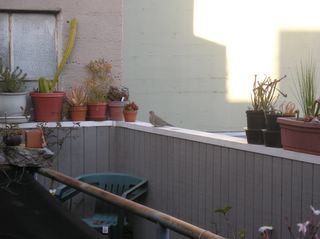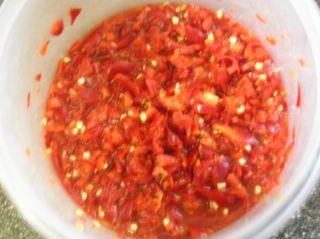Fertility is the New Black
Around the same time, for the last several years, we've had Morning Doves shack up on our deck, get biz-zay, and have babies. We didn't realize until a few years ago that our potted plants were the bird equivalent of king-sized, red satin sheet covered beds complete with mirrored ceilings and a Barry White tune playing softly in the background. In fact, it's almost creepy to wake up hearing their early morning coo-cooing, knowing that in people terms they're probably saying "Who's your daddy?"
Is this why they call them Morning Doves?
When I walk outside I feel like the third wheel at a sex party. It's just downright naaaasty.

Need a cigarette?
As if I needed to be reminded, Spring is the season for baby-making, baby-having, and hopeful fertility, so that that Life will keep on doing whatever it is that Life does. Easter, that time when rabbits do it like rabbits, and we hunt for "the egg" (gee, I wonder what that means), is coming up and nothing says Easter like Peeps, chocolate bunnies, and Linguica and Eggs.

This box of Peeps, parasitically sucking the lifesblood out of our fridge, has been attached since the early zeros.
Ground control: We have linguica. The linguica we made ourselves. Although we've been nibbling on it since Wednesday, this morning was the first chance I had to try a new recipe for linguica with eggs, which is a very common way to eat linguica for breakfast.
This whole linguica-making incident has sucked me into learning about Portuguese American culture and food. Since our linguica-making affair, I've been thinking a lot about 3 foods/beverages I saw at the event: linguica, homemade Portuguese wine, and hot red pepper sauce (which I later learned was something called Massa de Malagueta). Since then, I've been Googling Portuguese American food and culture, checking out cookbooks, and downloading Fados and Pezinhos.

Freezer Full of Linguica
One cookbook that I've checked out twice before is Portuguese Homestyle Cooking by Ana Patuleia Ortins. While I had browsed through this book before, it never really made a lasting impression until I experienced the food first hand. Many of the recipes are Azorean and it even has pages which discuss making linguica and wine. The recipe for the hot pepper sauce we had last weekend is in there, as is a recipe for linguica and eggs. Unfortunately, two dishes I had last year at a bullfight in Newman, deep-fried smelt (Peixes) and octopus stew (Arroz do Polvo), were not in the book (though there is one for baked sardines). But beyond that, many good recipes are in the book and in hindsight I should've paid closer attention before.
The recipe for the hot pepper sauce is extremely simple. In fact, when we were making it, Bruce said "is that it?"
"Yeah, that's it."
It is, I'm guessing, a way of preserving the peppers with salt, while the salt draws out water, changing the composition and flavor of the peppers. After 8 consecutive days of stirring, the paste is eventually stored in a jar with a topping of olive oil. Done this way, it keeps in the fridge for half a year. This sauce is often used in making linguica and on linguica as a condiment, as well as many other Portuguese dishes.

Insert rude comment here.
Yesterday we bought the red finger-sized peppers (I can never remember what they are called, but they weren't jalapenos or the smaller Asian chillis) at Ranch 99 in Daly City, a large Asian grocery chain based out of Southern California.
On our way out, guess what we found in the parking lot???
You'll never guess.
Ok, we found golden chantrelles!!! They were growing on an island in the parking lot that was bare except for a few scraggly plants and the woodchips the mushrooms were growing in. By the time we saw them they were too dried up, and who knows what dogs had been rehydrating them in the last few days, so we couldn't take them home to eat. But it amazes me that no one picked them when they were fresh, especially considering they were growing in the parking lot of an Asian market, where folks come from cultures that are less fungo-phobic than ours.

Day One: Hot Pepper Sauce.
Massa de Malagueta
(Hot Pepper Sauce)
1 pound of hot red, finger-sized, peppers
½ cup of kosher salt
1 tablespoon of white wine vinegar
1/3 cup of extra virgin olive oil
Rubber gloves
1. Wash and dry the peppers. Remove the stems and the cap. Now, for ultimate hotness, you should leave the seeds. Or you can discard half of the seeds from the peppers or include only a teaspoon if you are really concerned. However, before you do, it is advisable that you protect your hands with rubber gloves. You may also go without the gloves, as long as you wash your hands thoroughly with soap and hot water. And don't be touching any sensitive areas, like your eyes, while making the sauce. Otherwise, you'll feel like a left-wing protester peppersprayed by the police.
2. Section the peppers in half down the length, then again down the width. Place inside of a food processor and pulse until you have a consistency that is finely chopped by not pureed.
3. Transfer the peppers to a medium bowl or tupperware container and mix in the salt and vinegar. Cover and place in the fridge.
4. For 8 days, stir the mixture several times a day. At the end of 8 days, place inside a sterilized canning jar or container and top with olive oil. The sauce will keep this way in the fridge for 6 months.
Linguica and eggs is a pretty common breakfast item in a lot of restaurants in California. Incidentally, most of those restaurants are not Portuguese restaurants. It's really like going to a Denny's and seeing huevos rancheros on the menu. And right beside huevos rancheros will be a linguica omelette. As far as I know, this is the closest most non-Portuguese Californians get to Portuguese dining. The strangest thing; while there are many Portuguese in California, there are less than a handful of Portuguese restaurants and bakeries. To my knowledge, there is only one restaurant that serves Portuguese food in San Francisco. Though there are plenty of Brazillian restaurants, and while the two cultures intersect, they are not the same. In the San Joaquin valley, you can find Filipino restaurants, Mexican restaurants, Italian restaurants, but no Portuguese restaurants. If you want food made for Portagees by Portagees you really have three options: festas, bullfights, and marrying/befriending in.
A note on this recipe: linguica is often served this way for breakfast, a way that is similar to a very well-done omelette. However, Bruce says his dad and his uncles would also eat the linguica with fried eggs on the side. Also, I made this recipe with only 4 eggs, when it should've contained one more. I've made the correction in the instructions. Also, this recipe works best with a non-stick skillet.

Slightly Mise en Place
Ovos con Linguica serves two
(Linguica with Eggs)
2 tablespoons of olive oil
1 half of a small yellow onion, minced
2 fairly large links of linguica, cut into ¼" pieces
5 eggs, beaten
1 small handful of flatleaf parsley, chopped
1-2 teaspoons salt
1. Heat the oil over medium high heat and fry the onions. As soon as they start to brown, add the linguica and stir. Cook the linguica for about 5 minutes or until browned. Once browned, lower the heat to medium-low.
2. Add the chopped parsley and salt to the eggs and mix. Pour this mixture over the eggs and lightly stir. Then cook without stiring for another 10 minutes or until the eggs have set.

This could've used one more egg.
From this point, you have two options, you can either invert the omelette onto a plate and then back into the skillet to cook the other side, or you can take the whole skillet and place under the broiler to finish cooking the top. It really depends on how you want to present it. As you can see below, I did mine the skillet, plate, skillet way and it really isn't an attractive presentation, even if it does taste great. I suggest you play around with this recipe and if you are a pro at making these type of omelettes, I suggest you go with your own technique. However, my personal opinion is that liguica goes best with eggs cooked with the linguica, rather than off to the side.

Tastes better than it looks.
Now, about those chantrelles…
k.
Is this why they call them Morning Doves?
When I walk outside I feel like the third wheel at a sex party. It's just downright naaaasty.

Need a cigarette?
As if I needed to be reminded, Spring is the season for baby-making, baby-having, and hopeful fertility, so that that Life will keep on doing whatever it is that Life does. Easter, that time when rabbits do it like rabbits, and we hunt for "the egg" (gee, I wonder what that means), is coming up and nothing says Easter like Peeps, chocolate bunnies, and Linguica and Eggs.

This box of Peeps, parasitically sucking the lifesblood out of our fridge, has been attached since the early zeros.
Ground control: We have linguica. The linguica we made ourselves. Although we've been nibbling on it since Wednesday, this morning was the first chance I had to try a new recipe for linguica with eggs, which is a very common way to eat linguica for breakfast.
This whole linguica-making incident has sucked me into learning about Portuguese American culture and food. Since our linguica-making affair, I've been thinking a lot about 3 foods/beverages I saw at the event: linguica, homemade Portuguese wine, and hot red pepper sauce (which I later learned was something called Massa de Malagueta). Since then, I've been Googling Portuguese American food and culture, checking out cookbooks, and downloading Fados and Pezinhos.

Freezer Full of Linguica
One cookbook that I've checked out twice before is Portuguese Homestyle Cooking by Ana Patuleia Ortins. While I had browsed through this book before, it never really made a lasting impression until I experienced the food first hand. Many of the recipes are Azorean and it even has pages which discuss making linguica and wine. The recipe for the hot pepper sauce we had last weekend is in there, as is a recipe for linguica and eggs. Unfortunately, two dishes I had last year at a bullfight in Newman, deep-fried smelt (Peixes) and octopus stew (Arroz do Polvo), were not in the book (though there is one for baked sardines). But beyond that, many good recipes are in the book and in hindsight I should've paid closer attention before.
The recipe for the hot pepper sauce is extremely simple. In fact, when we were making it, Bruce said "is that it?"
"Yeah, that's it."
It is, I'm guessing, a way of preserving the peppers with salt, while the salt draws out water, changing the composition and flavor of the peppers. After 8 consecutive days of stirring, the paste is eventually stored in a jar with a topping of olive oil. Done this way, it keeps in the fridge for half a year. This sauce is often used in making linguica and on linguica as a condiment, as well as many other Portuguese dishes.

Insert rude comment here.
Yesterday we bought the red finger-sized peppers (I can never remember what they are called, but they weren't jalapenos or the smaller Asian chillis) at Ranch 99 in Daly City, a large Asian grocery chain based out of Southern California.
On our way out, guess what we found in the parking lot???
You'll never guess.
Ok, we found golden chantrelles!!! They were growing on an island in the parking lot that was bare except for a few scraggly plants and the woodchips the mushrooms were growing in. By the time we saw them they were too dried up, and who knows what dogs had been rehydrating them in the last few days, so we couldn't take them home to eat. But it amazes me that no one picked them when they were fresh, especially considering they were growing in the parking lot of an Asian market, where folks come from cultures that are less fungo-phobic than ours.

Day One: Hot Pepper Sauce.
Massa de Malagueta
(Hot Pepper Sauce)
1 pound of hot red, finger-sized, peppers
½ cup of kosher salt
1 tablespoon of white wine vinegar
1/3 cup of extra virgin olive oil
Rubber gloves
1. Wash and dry the peppers. Remove the stems and the cap. Now, for ultimate hotness, you should leave the seeds. Or you can discard half of the seeds from the peppers or include only a teaspoon if you are really concerned. However, before you do, it is advisable that you protect your hands with rubber gloves. You may also go without the gloves, as long as you wash your hands thoroughly with soap and hot water. And don't be touching any sensitive areas, like your eyes, while making the sauce. Otherwise, you'll feel like a left-wing protester peppersprayed by the police.
2. Section the peppers in half down the length, then again down the width. Place inside of a food processor and pulse until you have a consistency that is finely chopped by not pureed.
3. Transfer the peppers to a medium bowl or tupperware container and mix in the salt and vinegar. Cover and place in the fridge.
4. For 8 days, stir the mixture several times a day. At the end of 8 days, place inside a sterilized canning jar or container and top with olive oil. The sauce will keep this way in the fridge for 6 months.
Linguica and eggs is a pretty common breakfast item in a lot of restaurants in California. Incidentally, most of those restaurants are not Portuguese restaurants. It's really like going to a Denny's and seeing huevos rancheros on the menu. And right beside huevos rancheros will be a linguica omelette. As far as I know, this is the closest most non-Portuguese Californians get to Portuguese dining. The strangest thing; while there are many Portuguese in California, there are less than a handful of Portuguese restaurants and bakeries. To my knowledge, there is only one restaurant that serves Portuguese food in San Francisco. Though there are plenty of Brazillian restaurants, and while the two cultures intersect, they are not the same. In the San Joaquin valley, you can find Filipino restaurants, Mexican restaurants, Italian restaurants, but no Portuguese restaurants. If you want food made for Portagees by Portagees you really have three options: festas, bullfights, and marrying/befriending in.
A note on this recipe: linguica is often served this way for breakfast, a way that is similar to a very well-done omelette. However, Bruce says his dad and his uncles would also eat the linguica with fried eggs on the side. Also, I made this recipe with only 4 eggs, when it should've contained one more. I've made the correction in the instructions. Also, this recipe works best with a non-stick skillet.

Slightly Mise en Place
Ovos con Linguica serves two
(Linguica with Eggs)
2 tablespoons of olive oil
1 half of a small yellow onion, minced
2 fairly large links of linguica, cut into ¼" pieces
5 eggs, beaten
1 small handful of flatleaf parsley, chopped
1-2 teaspoons salt
1. Heat the oil over medium high heat and fry the onions. As soon as they start to brown, add the linguica and stir. Cook the linguica for about 5 minutes or until browned. Once browned, lower the heat to medium-low.
2. Add the chopped parsley and salt to the eggs and mix. Pour this mixture over the eggs and lightly stir. Then cook without stiring for another 10 minutes or until the eggs have set.

This could've used one more egg.
From this point, you have two options, you can either invert the omelette onto a plate and then back into the skillet to cook the other side, or you can take the whole skillet and place under the broiler to finish cooking the top. It really depends on how you want to present it. As you can see below, I did mine the skillet, plate, skillet way and it really isn't an attractive presentation, even if it does taste great. I suggest you play around with this recipe and if you are a pro at making these type of omelettes, I suggest you go with your own technique. However, my personal opinion is that liguica goes best with eggs cooked with the linguica, rather than off to the side.

Tastes better than it looks.
Now, about those chantrelles…
k.
 Hello and welcome. This food blog is based in San Francisco and I'm Kevin, the guy who writes it.
You may know me from my brief, but violent and cracked out, appearance on COPS. Actually, that wasn't me - he didn't even look like me.
I'm more than happy to entertain you, but please don't be so shy. You can comment below or contact me personally at baconprss at yahoo dot com. Oh, and I like to eat sometimes.
Hello and welcome. This food blog is based in San Francisco and I'm Kevin, the guy who writes it.
You may know me from my brief, but violent and cracked out, appearance on COPS. Actually, that wasn't me - he didn't even look like me.
I'm more than happy to entertain you, but please don't be so shy. You can comment below or contact me personally at baconprss at yahoo dot com. Oh, and I like to eat sometimes.

0 Comments:
Post a Comment
<< Home